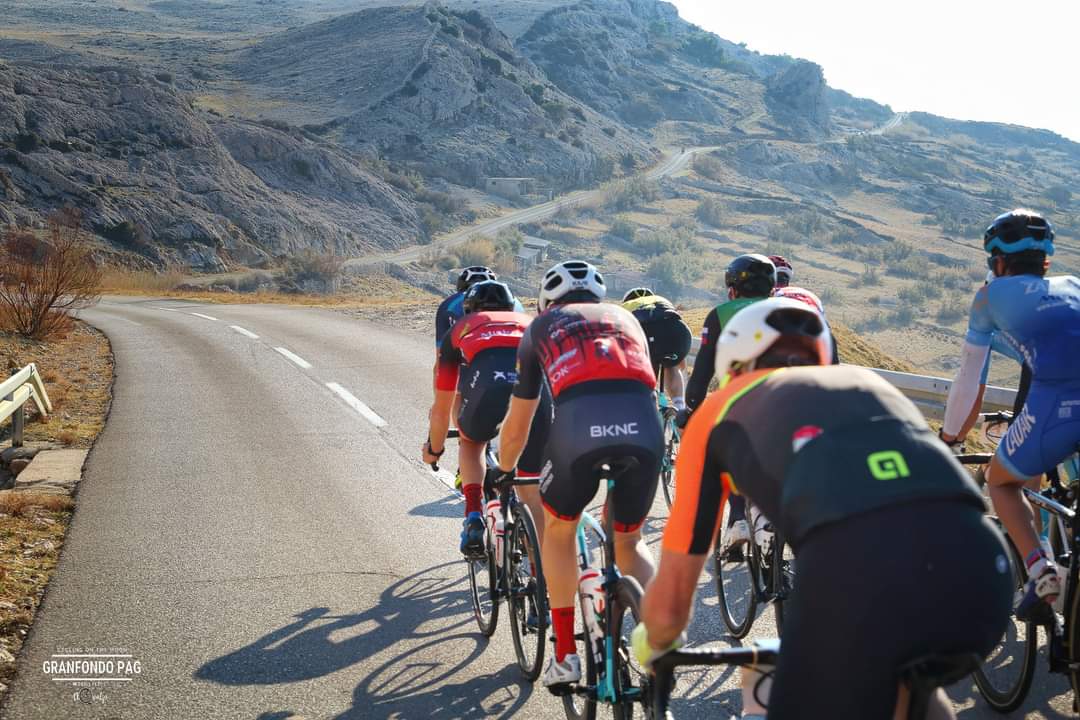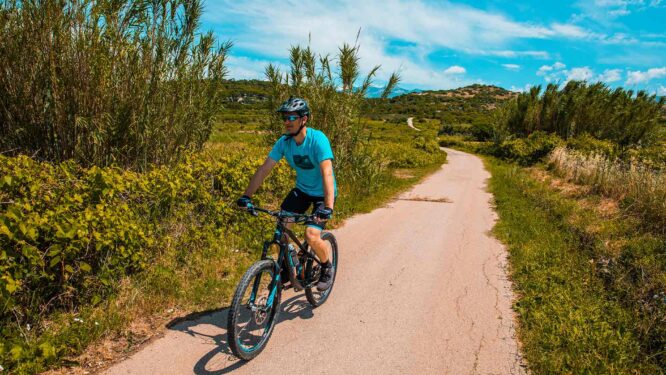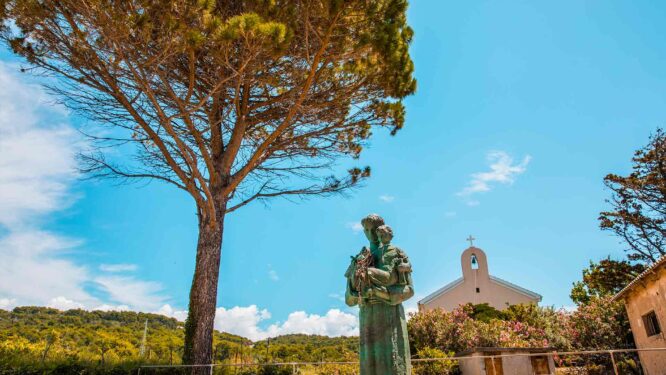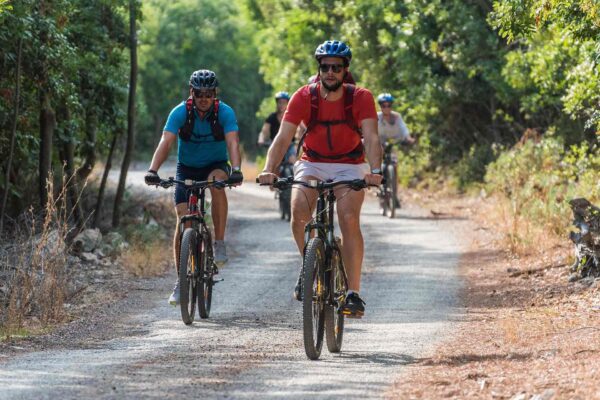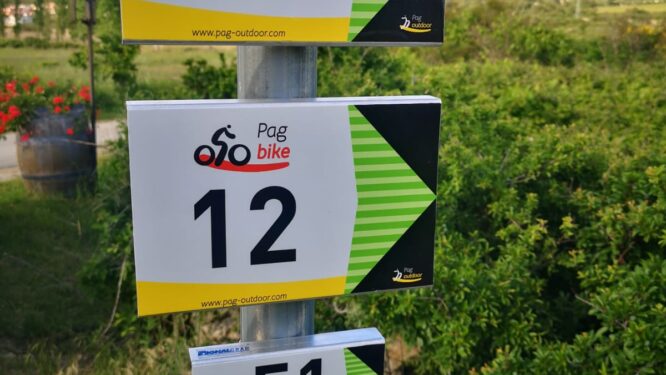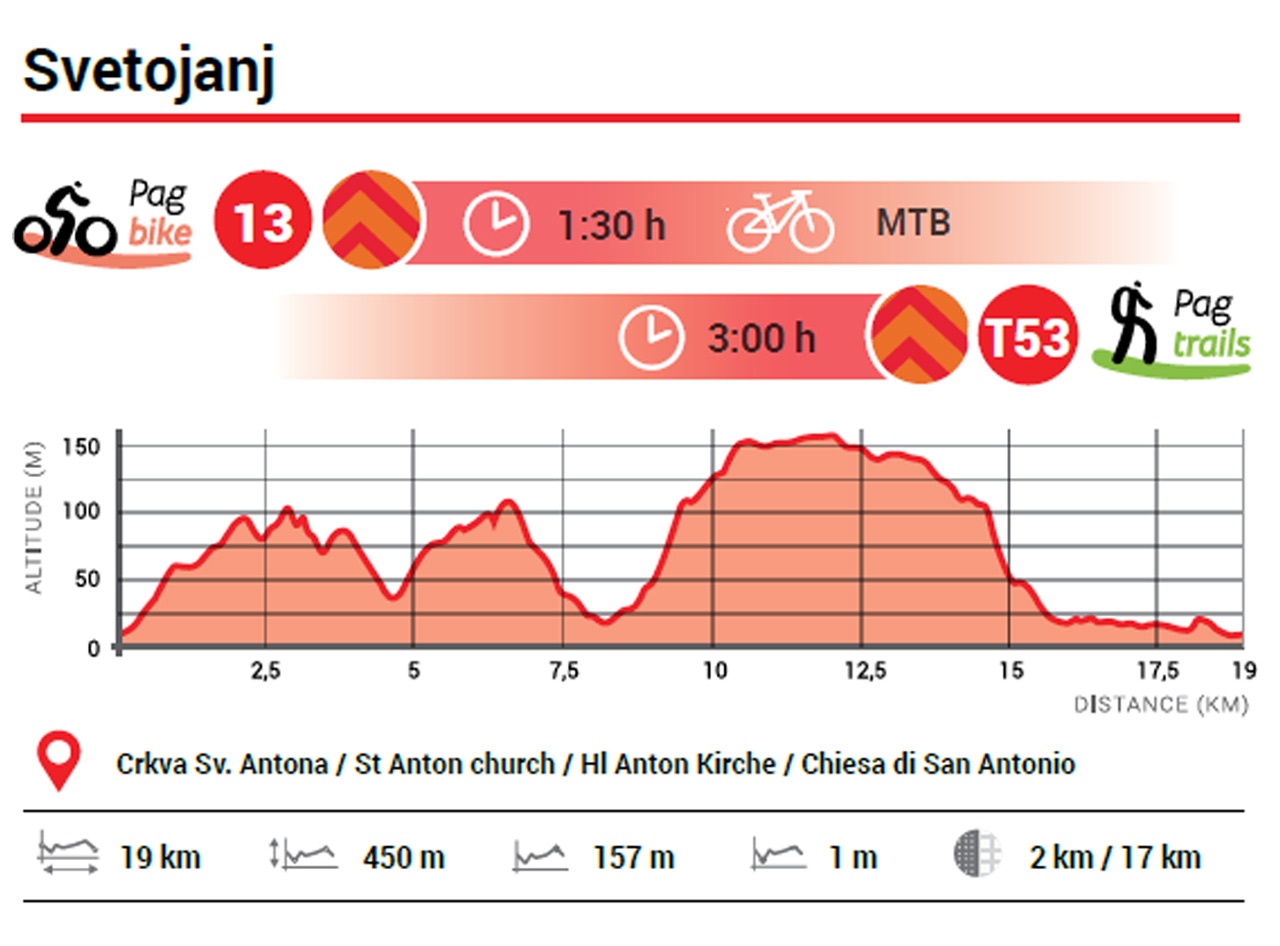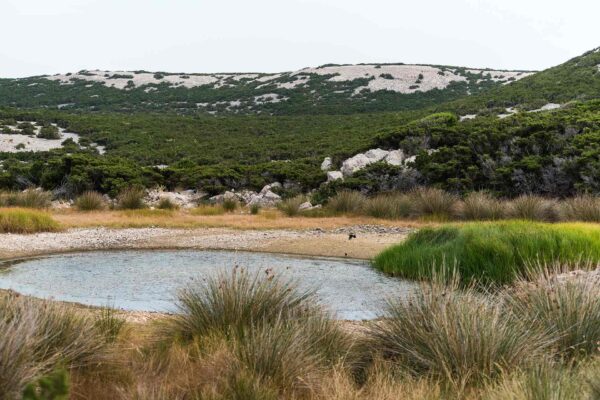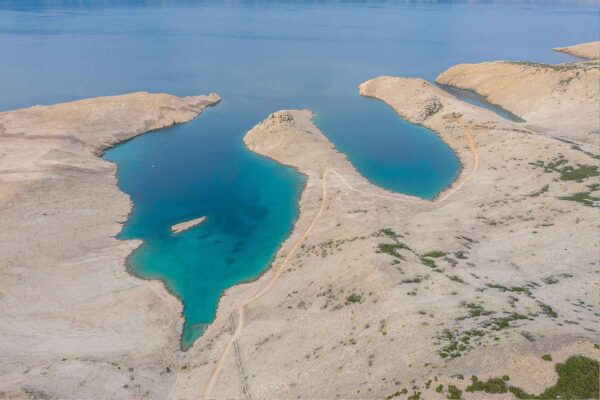The hinterland of Novalja – the Novalja fields – is criss-crossed with extensive bicycle trails that pass between the numerous vineyards. Cycling along these trails in peace and quiet, you’ll experience the beauty of this area in a unique way. The Novalja – Lun – Novalja Bike Race is a sporting event often held in our town.
The island of Pag is rich in trails that connect the villages and can be used for walking or cycling. Some of them offer real adventure and require professional sports and recreation equipment, such as mountain bikes or hiking gear. Other trails are less demanding and ideal for casual holiday participants. Here are some of the trails around Novalja:

ST. ANTHONY’S TRAIL
Church of St. Anthony – Novalja Field – Church of St. Anthony
It is a unique experience to ride or run across St. Anthony’s Trail, which is located in the green ring of the Novalja Field and is dotted with vineyards, olive groves and verdant pastures, where you are likely to encounter our native pet – the Pag sheep. This lightweight tour is perfect for families, the elderly and less experienced cyclists, as you traverse the winding asphalt, macadam, earth and rocky trails.
The starting and end point of the trail is the eponymous small Church of St. Anthony in the Novalja Field. The rolling surrounding green meadows and fragrant flowers of aromatic herbs complement the dulcet sounds of babbling fresh water springs at Škoplje which irrigate the reed-covered pond. This is a shelter for a bevy of bird species and amphibians, such as frogs, sea turtles, eels and other diverse fauna. On the first turn you will reach a macadam path lining a vineyard. If you stop for a short while and look around, you will see that the view extends to the entire Old Novalja and the bay, prompting your first photo opportunity.
We will then continue through the archetypal Mediterranean countryside distinguished by dry stone wall enclosures, dubbed “fencelets” (pens) by the locals. These small enclosures are used for holding farm animals or growing traditional crops. For this reason, one must always be mindful to close and not damage the pens and gates. The mostly macadam road will lead us to the asphalt main road in the Novalja Field from which we can go back to the starting point at the Church of St. Anthony.
Location: Novalja Field
Trail number: 11
Route: Church of St. Anthony – Novalja Field – Church of St. Anthony
Length (km): 5.3; Elevation gain (m): 60; Highest point (m): 39; Lowest point (m): 3; Trail type: Cycling – MTB; Asphalt: 1.7 km (32%); Macadam/earth: 3.6 km (68%); Surface difficulty: Easy; Fitness level: Easy.

NOVALJA FIELD TRAIL
Church of St. Anthony – Novalja Field – Church of St. Anthony
The Novalja Field is a natural green oasis that stands out from the rocky moonlike landscape that is typical for the northern part of the island at the foot of Mount Velebit. It boasts diverse vegetation, eye-catching Mediterranean scenery and an abundant fauna due to its fertile soil. Although the trail is elementary, it does feature a few somewhat demanding climbs and descents, which makes it suitable for families, the elderly and less experienced cyclists.
The trail begins and ends at the Church of St. Anthony in the natural environment of Novalja Field’s green oases, olive trees and oleanders. By following the bike or trail signage and after a slight ascent, the trail will lead us to the first checkpoint – the Boškinac Hotel which was awarded a Michelin star in 2020. After a brief and moderately difficult climb, we will reach an elevation, where the state-of-the-art Jarebica Hunting Lodge is located and an unparalleled view of the Novalja Field below unfurls before you. The scenic view and the Novalja Field in plain view are hotspots of this one-of-a-kind trail on Pag Island. After a gentle descent, the trail will take us into the heart of the Novalja Field along the route’s natural coastal landscape, peculiar “singles“ and broad macadam paths. We will pass through a quiet area amid the plentiful flora and fauna of the Novalja Field. Should your eyes wander around the surrounding, you might see a startled scurrying rabbit, a preying fox, a turtle lounging on the grassland or a grass lizard soaking up the sun.
The trail will then lead us to the asphalt main road of the Novalja Field at whose edges you can detect small ponds that sometimes flood the road during heavy rain. The aforementioned road will take us back to the starting point at the Church of St. Anthony. The idyllic environment is complemented by a reed-covered pond and a small rest stop with benches, tables and a fresh water spring. The shade provided by the tall treetops makes this the perfect place for relaxing, recharging and creating reminiscences of the Novalja Field!
Location: Novalja Field
Trail number: 12
Route: Church of St. Anthony – Novalja Field – Church of St. Anthony
Length (km): 4.9; Elevation gain (m): 120; Highest point (m): 84; Lowest point (m): 3; Trail type: Cycling – MTB; Asphalt: 1.8 km (37%); Macadam/earth: 3.1 km (63%); Surface difficulty: Easy; Fitness level: Easy.

SVETOJANJ TRAIL
Church of St. Anthony – Old Novalja – Zaglava – Svetojanj – Zaglava – Novalja Field – Church of St. Anthony
Svetojanj is an exceptionally alluring, yet a technically difficult and challenging trail with a special visual experience and exceptional scenery in which lush vegetation is juxtaposed with the barren rocky terrain. It was named after the ancient Byzantine fortress of Svetojanj from the 6th century during the reign of Justinian I.
Peak physical fitness, experienced agile cyclists, riding on macadam, earth, gravel and karst trails with steep inclines and declines in a natural Mediterranean environment – if this description matches your abilities and affinities, then Svetojanj is the perfect trail for you!
So let’s get this show on the road!
The starting point is in the Novalja Field, outside the Church of St. Anthony, in an enchanting location above a pond surrounded by high reeds. On the edge of the pond, in the shade of the tall trees, you can cool off in a fresh water spring which runs dry in the summer. With that in mind, make sure to bring at least 1.5 l of water, dextrose, fruit and energy bars considering the difficulty of the 19 km-long trail.
The trail will take us to the small coastal village of Stara Novalja, where we continue on a macadam road. The Mediterranean flora and karst take turns as we ride through the unspoiled nature brimming with colourful vistas. The intoxicating scent of indigenous plants and herbs slowly dissipates as we reach Zaglave, the part of the island that is famous for its barren rocks that are exposed to the thrashing bora and the salt sediments. This is the reason why vegetation is sparse in this area, although it also clearly demonstrates why Pag has been given the sobriquet “Moon Island”. Caution is advised here because the remote and sunlit karst area of Zaglave is the perfect habitat for horned vipers, the only species of venomous snake on the island.
Our next stop and site is the Svetojanj fortress, one of the most impressive and biggest attractions of this trail. The ancient fortress was erected in the 6th century during the reign of Justinian I as an observation post and a pivotal defensive element in a system that was used to protect Byzantium’s maritime interests during its initial period of domination in the Adriatic. It is one of the most fascinating checkpoints on the eponymous Svetojanj bike route! After stopping at the fortress and following an arduous climb, we will arrive at an observation deck where you can enjoy a wonderful view of the Velebit Channel. This is one of the most stunning panoramas of the entire island.
Continuing further on a macadam path up a steep slope, we will come to Svetojašnica, a small and captivating 100-year-old natural pond, one of only a few that have been preserved on the island. For years, this oasis in the heart of Zaglave has been the only watering hole for Pag sheep and, according to a local legend, it has only run dry once over the last 100 years – in the 1980s during a dry spell that lasted from May until November. The enthralling scenery beckons you to stop, while the scent of the sea and salt restores lost energy. We resume riding through the rocky landscape, passing the quarry on our way, until we reach the Novalja Field, a verdant oasis that is a stark contrast to the previously encountered barren terrain and the home of numerous animal species.
The Novalja Field also abounds in drinking water, the source of life, as the ancient Romans were well aware when they carved out a 1100 m-long underground aqueduct out of solid rock in the 1st century AD by connecting the field with the settlement of Novalja. The Roman aqueduct, dubbed the “Italian Hole” by the locals, is displayed at the Town Museum, where you can walk around a small area of its interior (www.gradskimuzejnovalja.hr). You will also learn everything there is to know about the architecture of classical antiquity, in which style it was built, the nine openings that stretch along the Novalja Field, and the role of our most valuable cultural monument from the Roman Era.
Don’t be surprised if you encounter wild animals in the Novalja Field, such as rabbits, pheasants, blindworms, turtles or quail, as they are quite common in this area. We then continue on our bikes surrounded by olive groves, vineyards and dry stone wall enclosures with domesticated animals, and if you cast a glance over the dry stone walls, you will see sheep, goats or poultry. The tour of Novalja Field ends exactly where we started, at the Church of St. Anthony.
Curiosities :
- Antique aqueduct
- Castle Svetojanj
- Pond Svetojašnica
Location: Novalja Field – Old Novalja – Zaglava – Novalja Field
Trail number: 13
Route: Church of St. Anthony – Old Novalja – Zaglava – Svetojanj – Zaglava – Novalja Field – Church of St. Anthony
Length (km): 19.0; Elevation gain (m): 450; Highest point (m): 160; Lowest point (m): 3; Trail type: Cycling – MTB; Asphalt: 2.1 km (11%); Macadam/earth: 16.9 km (89%); Surface difficulty: Strenuous; Fitness level: Strenuous.
THE VODICE TRAIL
This trail connects Pag and Novalja through some interesting residential areas. This is a macadam trail, not too demanding for beginners and with many places to stop for refreshments. Half way along the trail is a spring of fresh drinking water. You will also see an ornithological nature reserves along the train.
THE KOLAN TRAIL
This trail allows you to reach Pag or Novalja from the area of Kolan. Although relatively demanding, especially on the route by Mandra, this trail is interesting because you pass through fields and gullies. You can also purchase local products in Kolan.
THE KAMENOLOM TRAIL
This starts at the Old Novalja ferry dock and ends on Zrće Beach. Ten kilometres long, it runs past several beaches and allows you to branch off towards Žigljen, where a UFO park is located. The most important part of this trail, and the reason it got its name, is the fact that you can see the stonepits.
THE WINE TRAILS
The trail to the wine cellars isn’t an easy one – it is steep and sharp and it requires focus and physical strength. The trail to the wine cellars is marked by views of the Novalja Fields and it offers a welcome menu.
THE NOVALJA-LUN TRAIL
This is the best trail for getting to know the Novalja area. During the high season, it is necessary to be careful since this trail is also a road. The route includes relaxation on the beaches of Potočnica and Jakišnica, while the Lun olive groves offer a special kind of experience. Some of the olive trees are up to a thousand years old.
RULES OF CONDUCT
A bike ride or jog through the green ring of the Novalja Field and the settlement of Zaglava (including the Svetojanj peninsula and fortress) is bound to leave you with fond memories and in awe of the stunning features along the trails. In order to make the tour of these trails and area as pleasant and safe as possible, we recommend that you adhere to the following rules of conduct. In many places, the paths and trails have been enclosed with fences and gates by the local residents for the purpose of holding sheep. Be mindful of these gateways and close the gates behind you! Preserve the ground on which you ride by maintaining a minimal impact on the trail (e.g. when braking). Be mindful of the enclosed roads and trails (ask if you are unsure) and avoid trespassing on private property. Leave no trace and do not litter! Respect other trail users. If you come across people and animals, announce your presence in a timely manner – a friendly greeting or ringing a bell are welcome gestures. Cautious movement in the vicinity of animals will mitigate their reactions and fear, so make sure that you refrain from chasing away farm and wild animals.
This area abounds in flora and fauna and is also the habitat of certain snake species. While the grass snake, leopard snake and the four-lined snake (ratsnake) are non-venomous and therefore harmless, they still may evoke fear and discomfort in passers-by. The same happens when encountering a grass lizard, a non-venomous dark brown lizard similar to a snake. Increased caution is advised during the spring and summer months in sunlit karst areas which are the habitat of the only local venomous snake – the horned viper. Please note that the snakes will not show signs of aggression if unprovoked, so respect their habitat and do not disturb them in any way.
We recommend using a helmet and other equipment, as well as bringing sufficient amounts of water or other beverages. Learn about trail conditions in advance.
Enjoy our trails!








